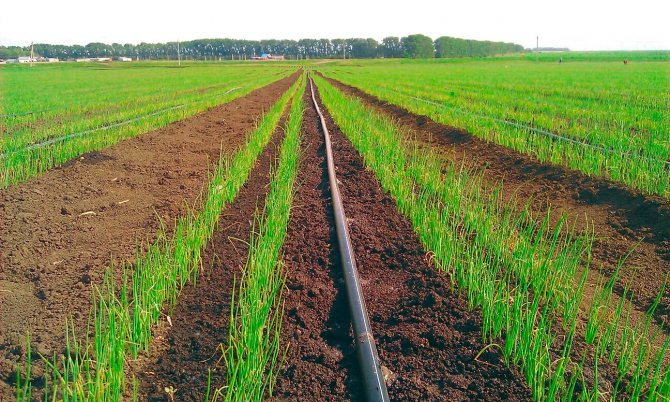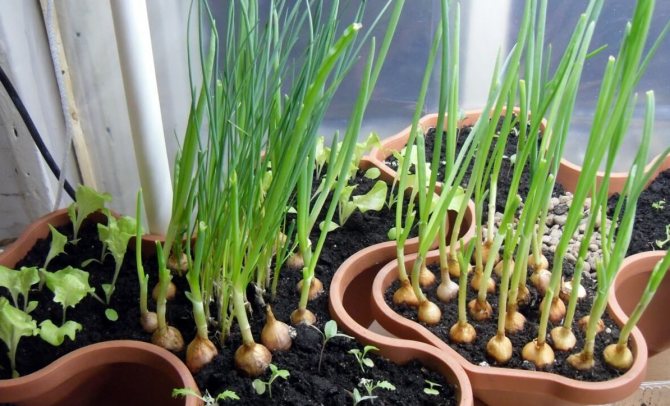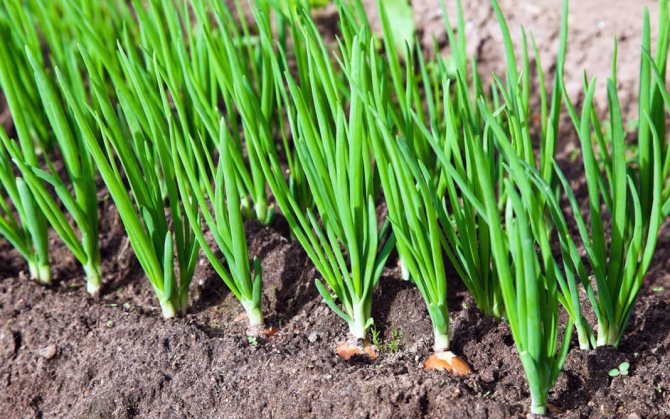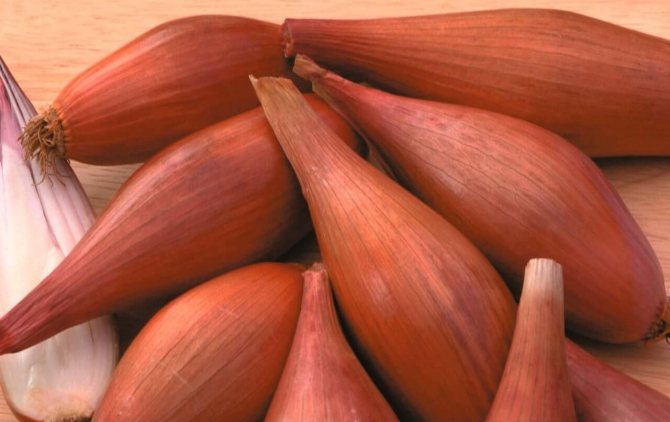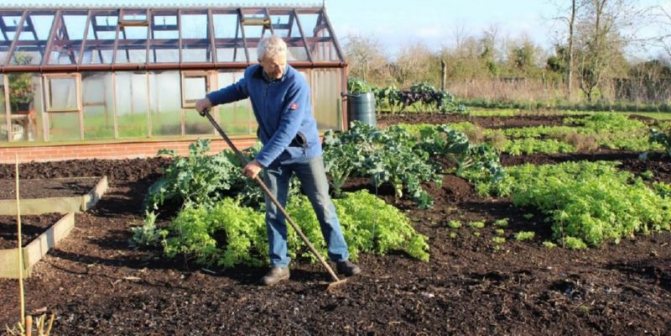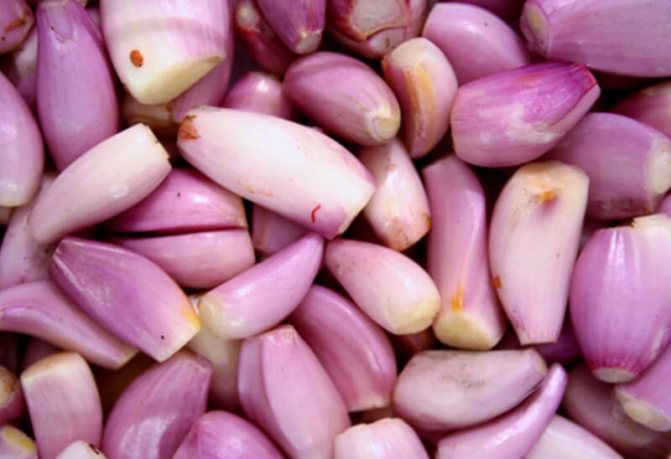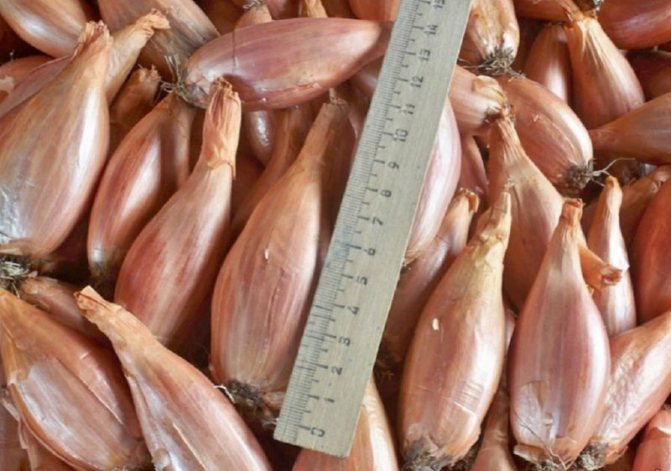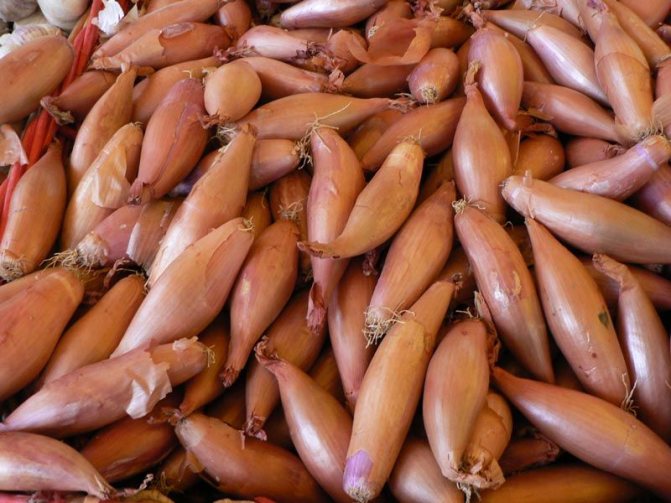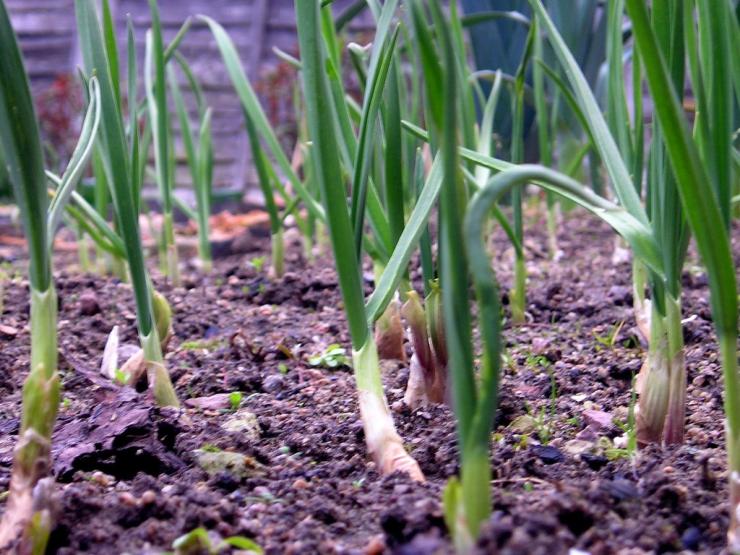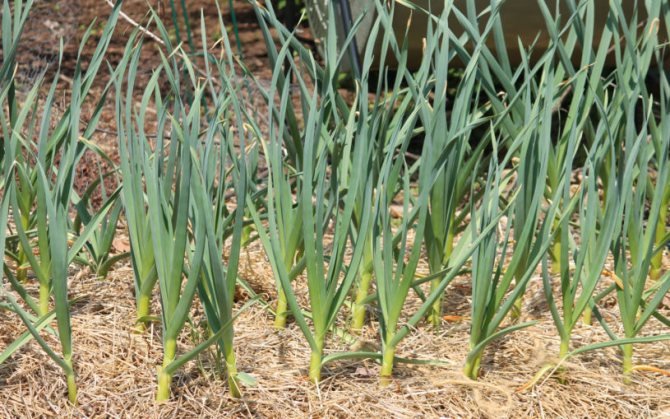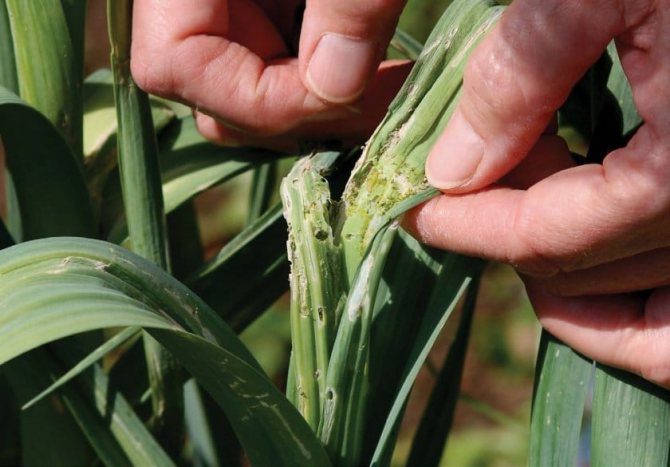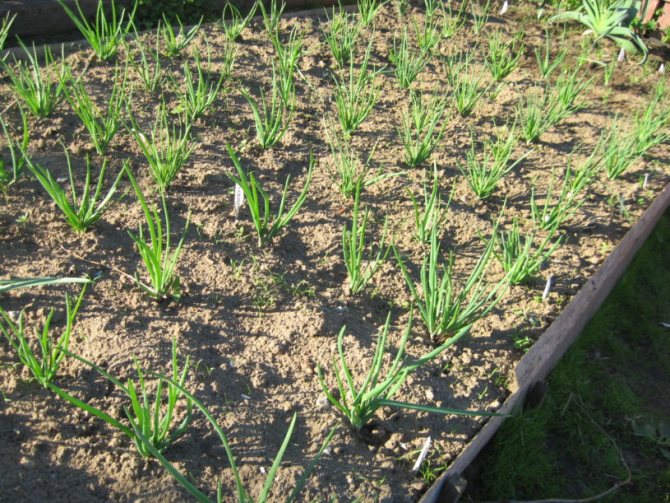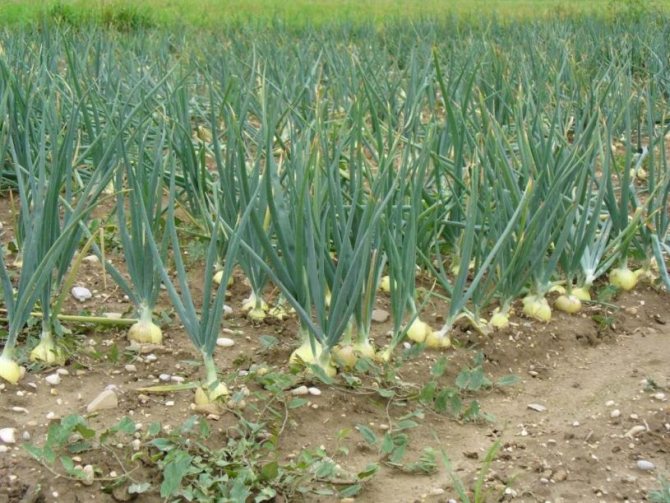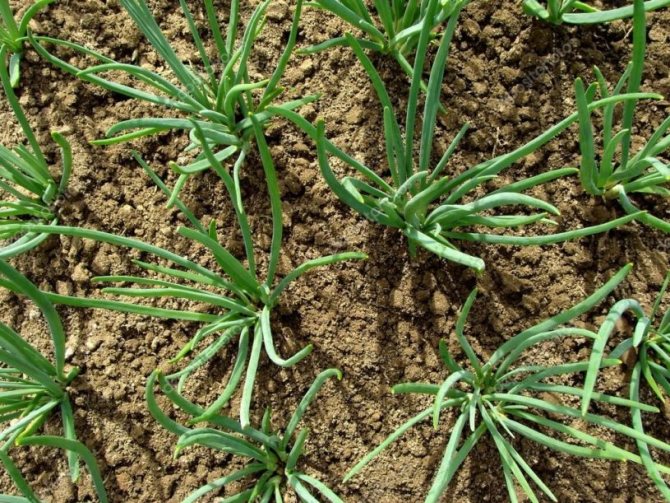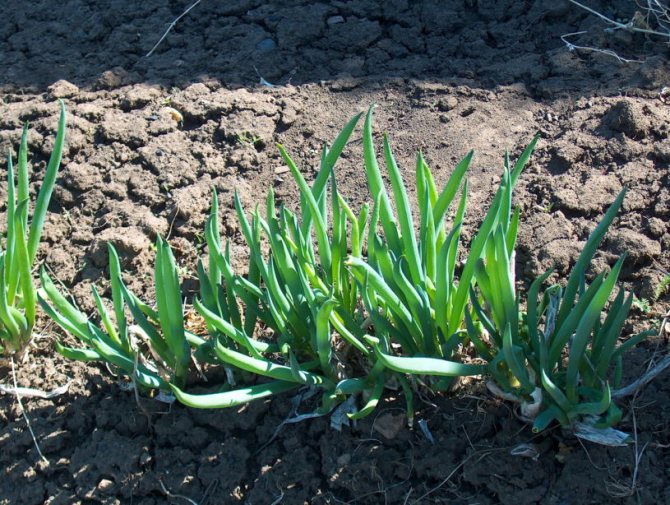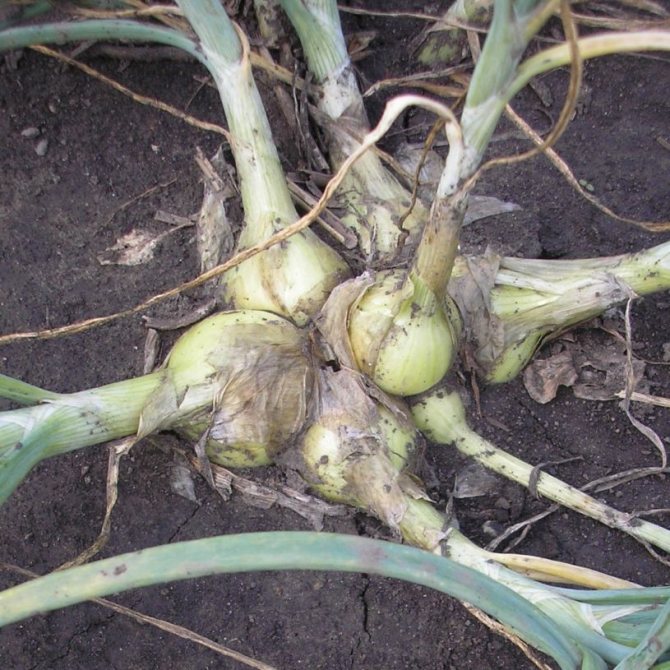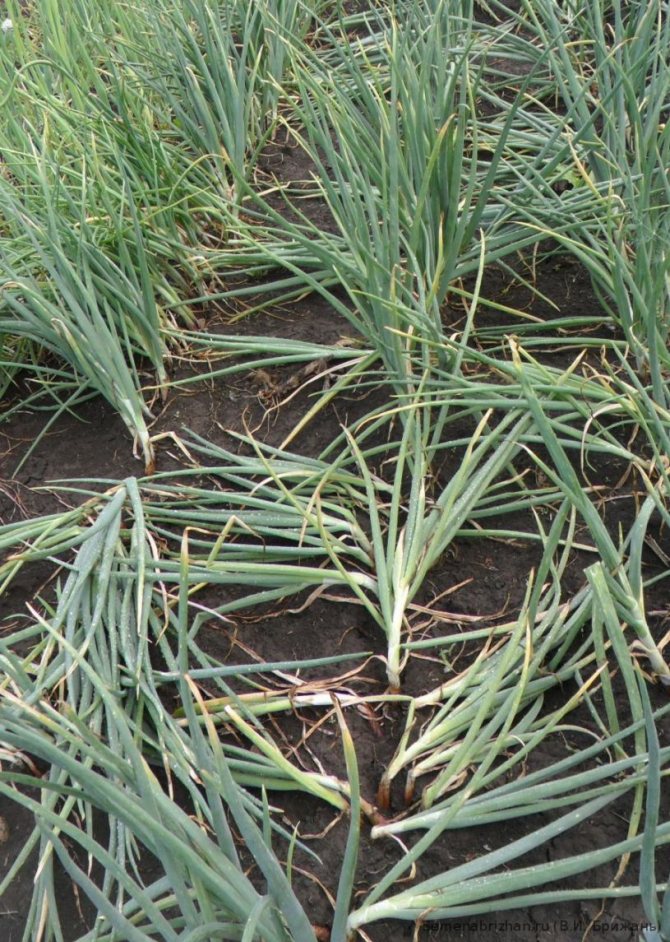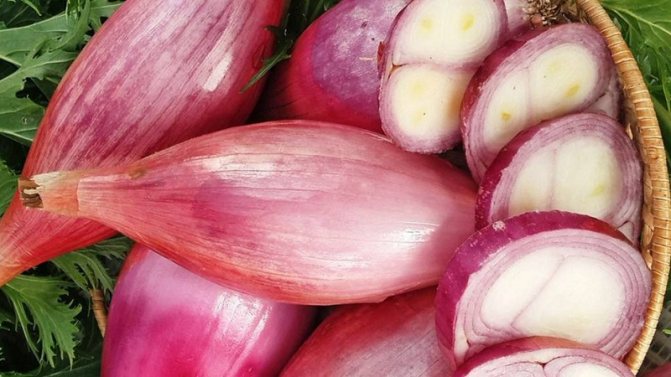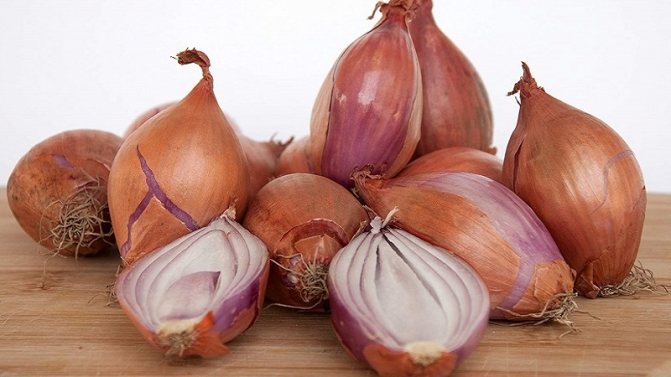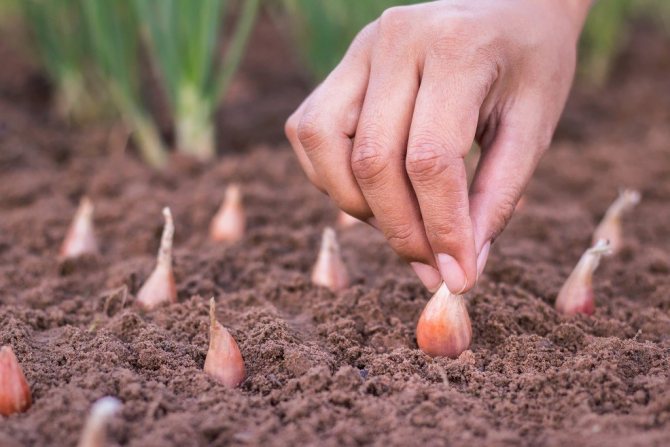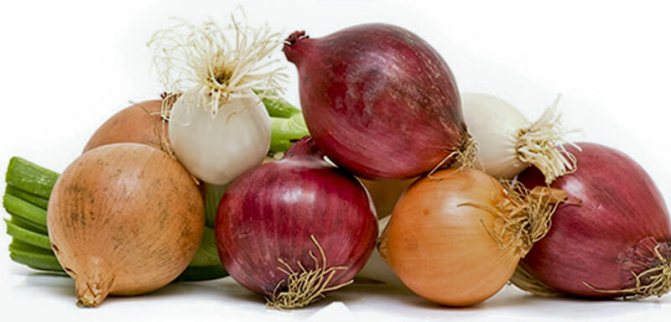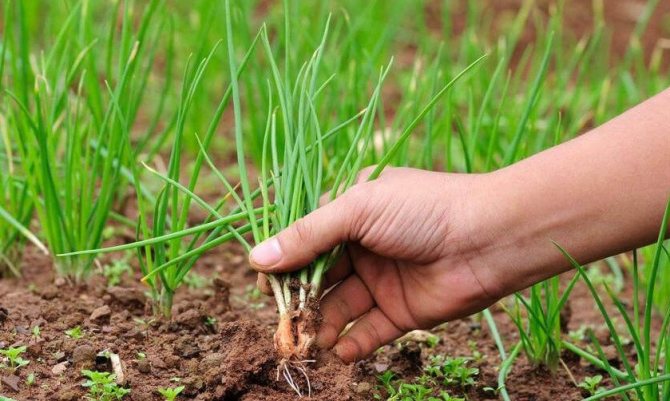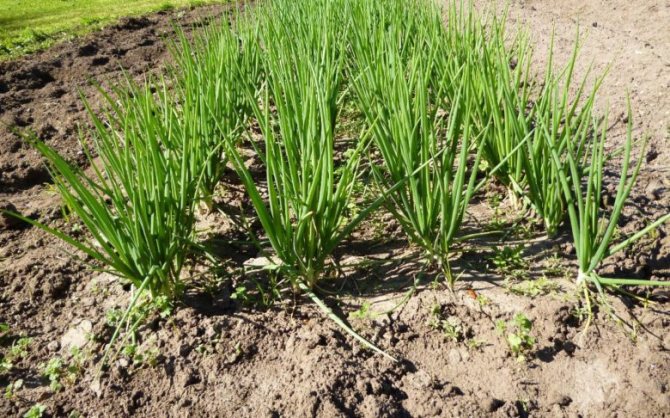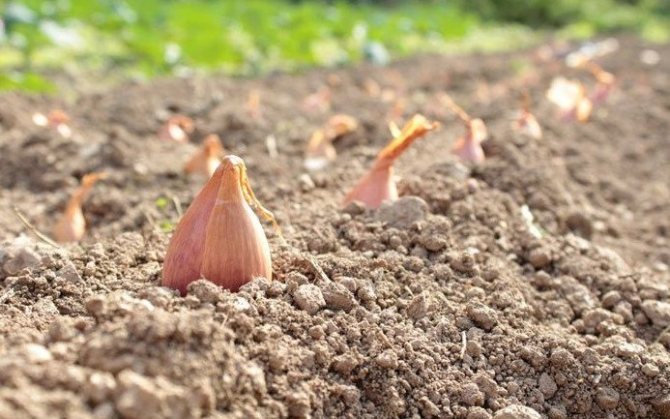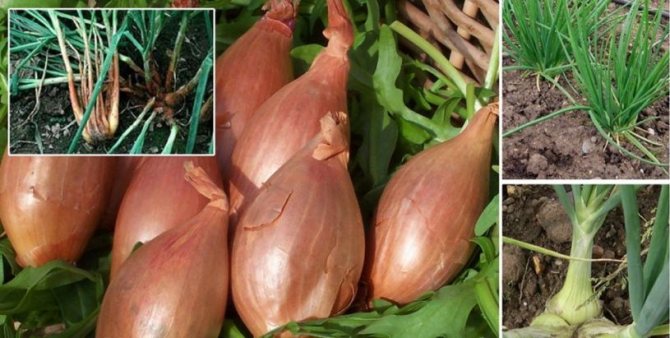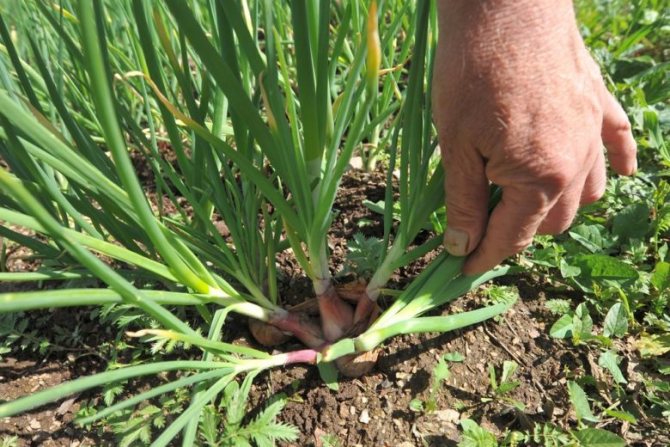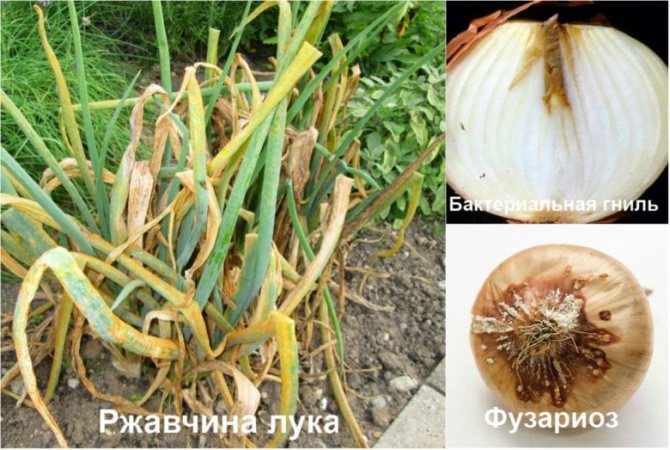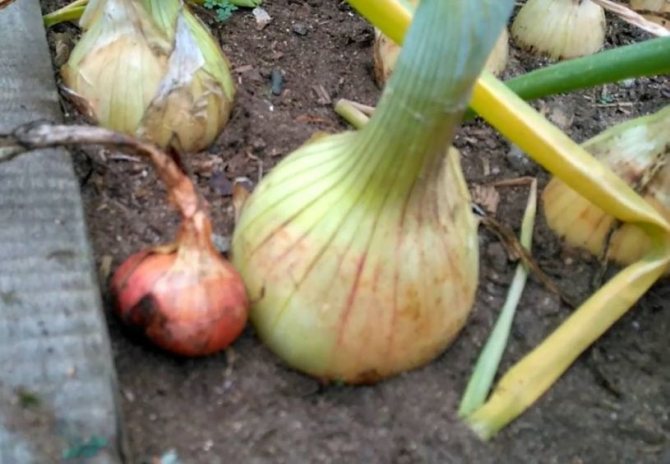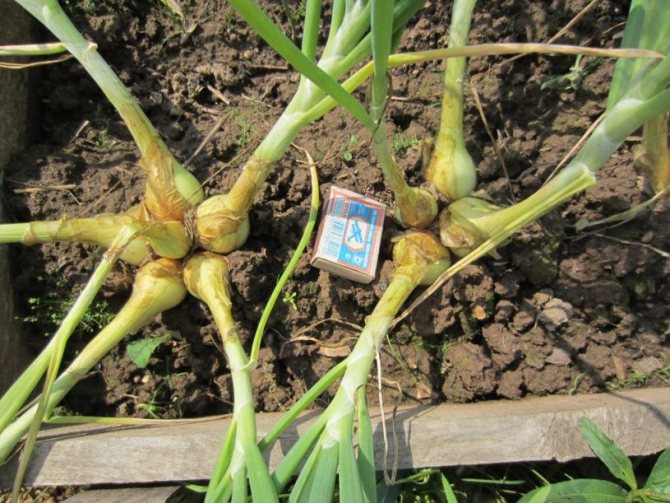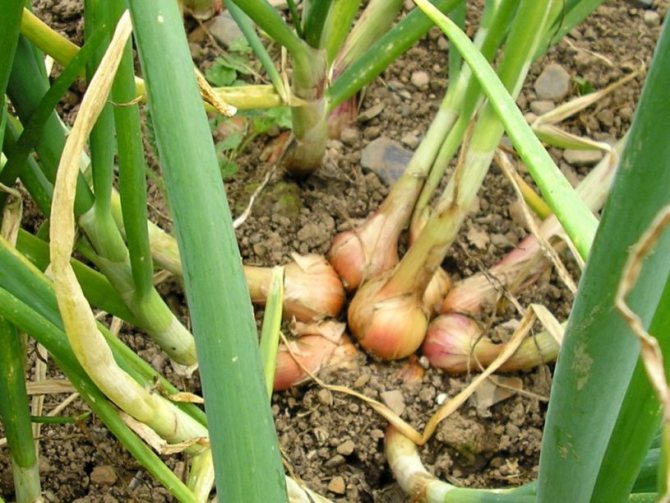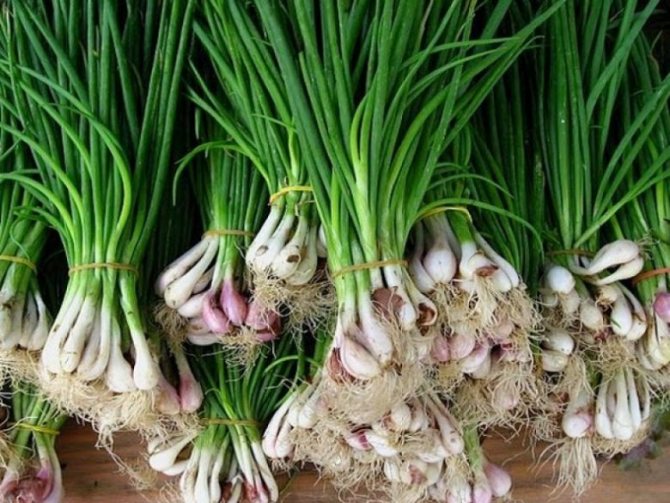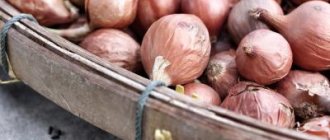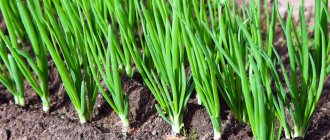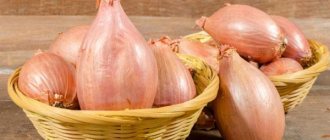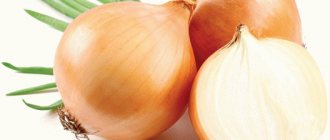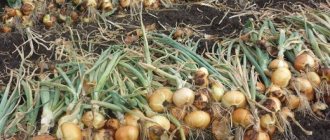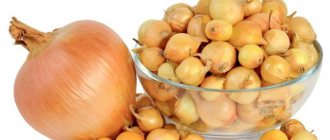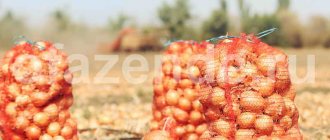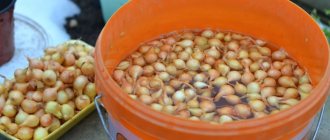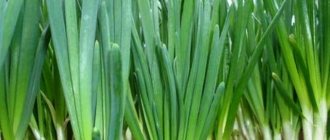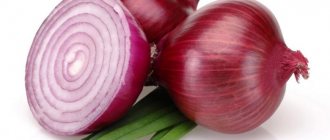A delicacy representative of the Onion family is shallots - a biennial herb that, when ripe, acquires many small cloves, which resembles garlic. It belongs to the types of onions, however, it differs not only in external qualities, but also in taste. What is a shallot, and how to cultivate it in a personal plot, we will find out further.

Shallots are a biennial plant
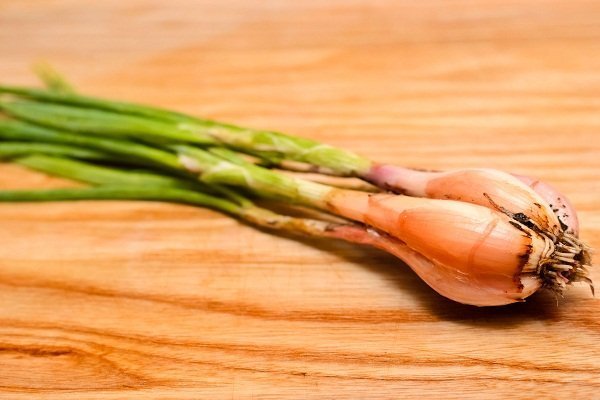

In shallots, not only the bulbs are considered tasty, but also the feathers.
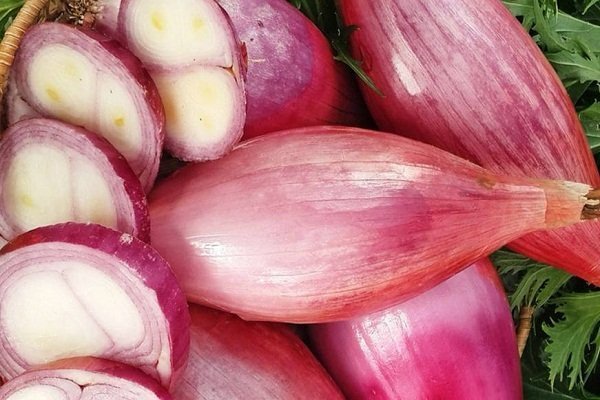

Shallots have a delicate sweet taste
Description of shallots
Early ripening shallots are a biennial plant that has been mentioned since the 3rd century BC. Nowadays, it is especially popular in France and begins to actively occupy more space on the shelves of different countries of the world. The characteristics of the plant that all gardeners should know about are presented in the table below:
| Parameter | Description |
| Origin | The birthplace of this plant has not been precisely established. The first mentions of him are found in the works of Theophrastus (372-287 BC). There is a theory that it was first consumed in food about 5 thousand years ago in the south-west of Israel, or rather in the city of Ashkelon. For this reason, it is also called Ashkelon onion (Allium ascalonicum). According to other sources, shallots originate from Asia Minor. Some experts believe that he comes from the Mediterranean region. It is believed that the plant came to Central Europe from Greece in the 13th century thanks to the knights-crusaders. In the CIS countries, shallot first appeared in 1958, when it was bred by breeders from the Kuban and Kharkov regions. |
| Cultivation areas | The most favorable areas for the cultivation of shallots are the southern territories. In practice, it is actively planted not only in Western Europe, but also in Ukraine, Moldova, the North Caucasus and Transcaucasia. Some vegetable varieties are acclimatized and suitable for cultivation in the northern regions. These varieties include Bonilla, Earring and Red San Shallot. |
| Growing period | The crop is suitable for growing all year round. In spring and summer, you can cut fleshy feathers with a waxy coating and a pleasant taste, and in autumn and winter, you can collect onions directly. |
| Germination method | Bulbs grow at the same time, forming a kind of nest of small heads. On one plant, there are from several pieces to several dozen heads. Due to this feature, the onion is also called family or nesting. Its other name is shrew. Each head weighs about 200-300 g. The height of the arrows, on which loose umbellate inflorescences appear, reaches about 100 cm. They also include flowers that have no decorative value. |
| Fruit characteristics | The main vegetative organ of the plant is a small bulb, which has the following characteristics:
|
| Planting material | Shallots are often grown by planting their heads, so there is no need to sow seeds to get good planting material. So, you just need to leave part of the crop for planting next season. For this feature, onions are also called potato. However, with vegetative propagation, it must be borne in mind that the onions after some time lose their varietal qualities and gradually accumulate diseases, which negatively affects the yield. To fix this, you need to use fresh planting material or independently grow a set from seeds that remain viable for 2-3 years. In the first year, they will give heads that resemble garlic and break down into 5 onions. When planting them, you can get nests of numerous bulbs already at the beginning of the next season. |
| The benefits of onions | Shallot is valued for its medicinal properties - it helps with diseases of the gastrointestinal tract and eyes, does not injure the gastric mucosa due to its delicate taste, produces an anti-inflammatory effect and prevents the development of tumors due to the content of flavonoids. Onions are also useful for the content:
|
| Cooking applications | Both bulbs and feathers are used in cooking. They are used fresh, fried, baked and pickled. In Iran, it is customary to serve an original sauce for barbecue - grated shallots with yogurt, and in China popular chips are prepared from it. Shallots are especially popular in France, where they are used to prepare most sauces, delicacies and dishes with poultry and wild animals. |
| Contraindications | In large quantities, shallots should not be eaten for problems with the gastrointestinal tract and urinary system, as it can make it difficult to urinate. It is recommended to completely exclude it from the diet in case of bronchial spasms, kidney and liver diseases. In addition, onions are contraindicated for people with high acidity of the stomach - it increases the level of acid and thereby irritates the mucous membrane. |
The secrets of shallots are described in the following video:
Is harm possible
Bubbles, decorative varieties, photos, description, growing conditions, care
Shallots have no direct contraindications to use, but can cause a deterioration in the body's condition in various diseases. First of all, the restrictions apply to people with acute diseases of the gastrointestinal tract: gastritis, peptic ulcer disease, hyperacidity of the stomach. In this case, the onion can be harmful by severe irritation of the already weakened mucous membrane. There is also a possible difficulty in urinating during inflammatory processes in the genitourinary system. Such moments should be discussed with the doctor, and, if he gives permission, introduce the vegetable into the diet gradually, observing the reaction of the body.
Differences from onions
Shallots resemble regular onions in that they have a fleshy head and long green feathers, and a two-year growing season. However, there are differences between these two cultures, and they are as follows:
- shallots grow in nests, and onions grow singly;
- the shallot head consists of several cloves, which resembles garlic and differs from onions, which in the section consist of concentric rings;
- shallot has a more tender and pleasant pulp, but the aroma is not as sharp as that of its relative;
- shallots are able to withstand lower temperatures and ripen much faster than onions;
- shallots can be stored even at room temperature, but onions are more picky about storage conditions and wither quickly;
- in the composition of shallots, sugar content prevails, therefore it has a high calorie content per 100 g - 72 kcal versus 40 kcal for onions.
Shallots - useful properties
What is the difference between shallots and onions? These are not only external differences, the Ashkelonian surpasses him in the amount of vitamins and nutritional value. Shallot contains more sugars, various trace elements, phytoncides. It contains especially a lot of essential oil, and feathers contain up to 60-70% vitamin C.
The menu of the legendary French cuisine is difficult to imagine without the presence of shallots there, and it is France that takes the leading place in the cultivation of this crop. The spicy and aromatic Ashkelon onion is used in all kinds of soups, meat dishes, for pickles and salads. Shallots (look at the photo) are not only a delicacy, because their regular consumption helps to improve vision, reduces the risk of cancer, and normalizes blood pressure.
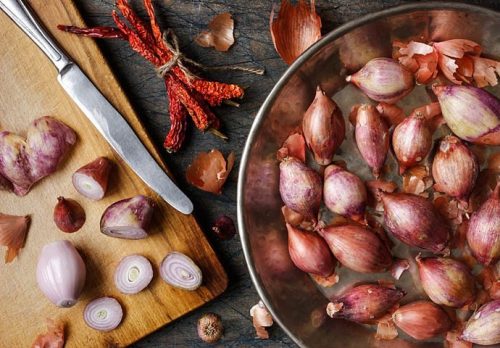

Popular varieties
There are many varieties of shallots on the market, which can be classified into three groups based on ripening times. Let's consider each of them separately.
Early
These include varieties, the green feather of which ripens in 18-22 days, and the leaves lodge 65-70 days after germination. Popular early varieties are:
- Vitamin basket... An excellent option for growing both in the greenhouse and in the open field. Bulbs weighing up to 30 g have a yellow husk and a juicy crispy white flesh.
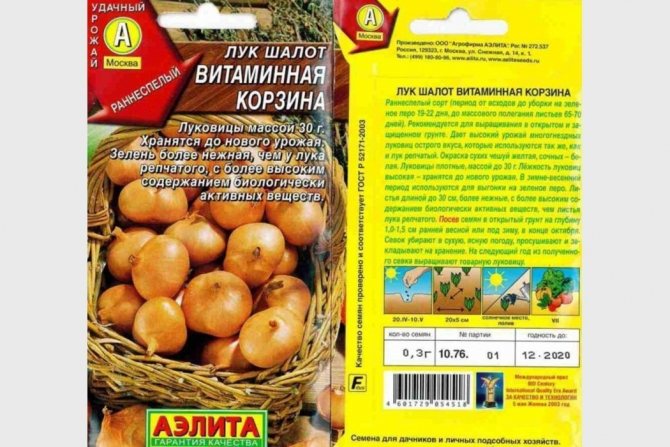

- Emerald... It produces bulbs of a rounded shape and weighing 20-30 g. They are covered with a brownish-pink husk and have a white semi-sharp flesh. 4-5 bulbs grow in the nest. From 1 sq. m of plot, you can collect 1.2-1.4 kg of fruit. Their shelf life is up to 10 months.
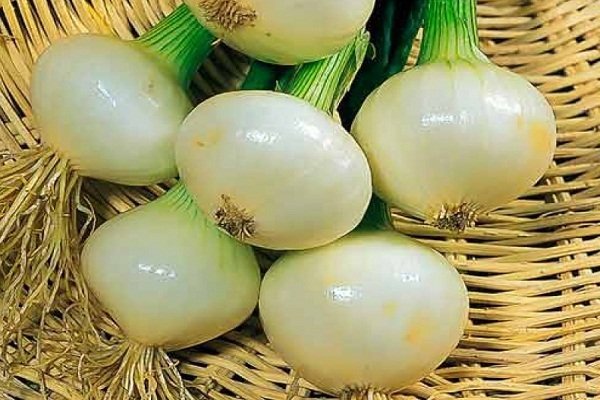

- Snowball... The bulbs are egg-shaped, gain up to 35 g in mass and acquire a pungent taste. From 1 sq. m beds can be harvested up to 1.9 kg of crop. You can store the fruits for up to 7 months.
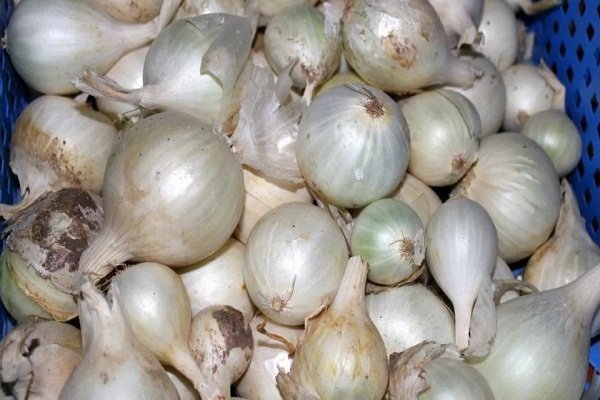

- Sprint... Downy mildew resistant variety that can be harvested at the end of July. Great for growing on greens. The bulbs themselves are obtained in 20-35 g. They have a sharp light yellow pulp with a pink tint.


- Belozerets 94... Bred at the P.P. Lukyanenko Krasnodar Research Institute of Agriculture. The variety is valued for its good keeping quality and high yield (up to 15 tons per hectare). The fruits are formed oval-round or rounded, weigh an average of 21-27 g and have a sharp juicy pulp of lilac-purple color. The bulbs are covered with a pale lilac husk with a yellowish tint.
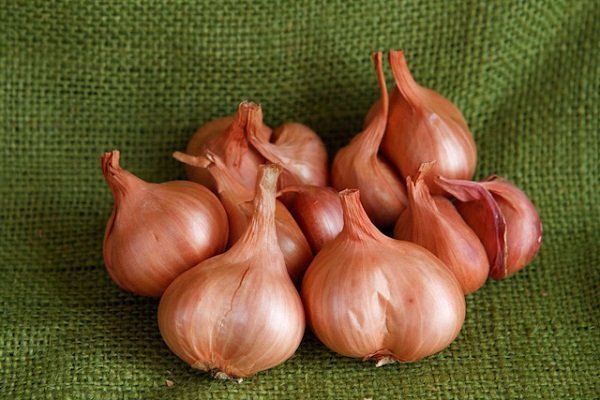

- Cascade... Fruits in bulbs weighing up to 35 g, which have a wide ovoid shape, juicy pulp and light pink husk. In each nest, 5-6 such bulbs are formed. It will be possible to harvest 17 tons of fruits from 1 hectare.
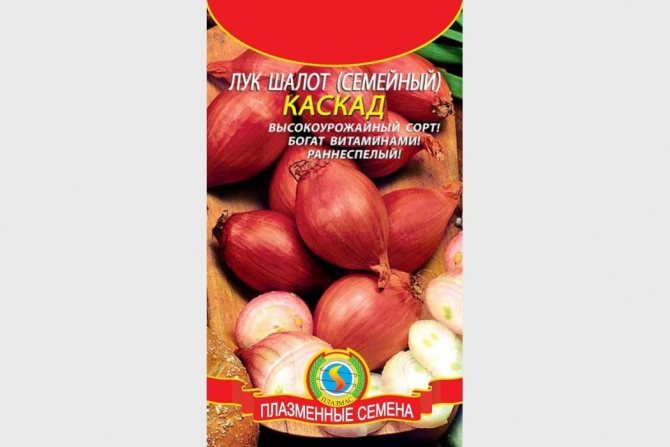

- Family... If you need a variety that is resistant to frost and disease, then this is a great option. The plant produces rounded bulbs weighing 22-25 g. They are covered with a brownish-yellow husk with a purple tint and have a white flesh with a mild semi-sharp taste. In one nest, 3-4 such fruits appear. They are great for preparing salads and vegetable dishes.
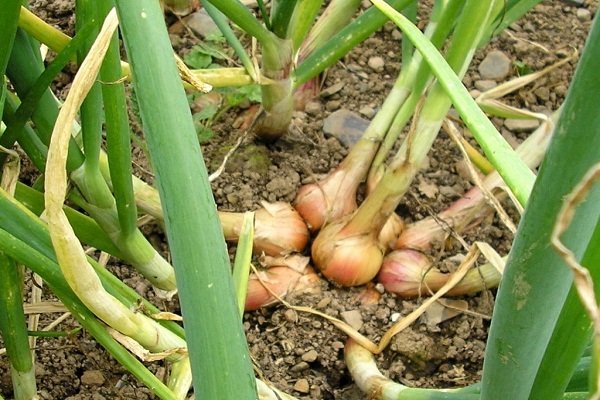

- Sir-7... Bred by breeders from SibNIIRS, therefore it is suitable for cultivation in the northern regions. The variety bears fruits weighing about 20-35 g, which have yellow scales with a pink tint and a pungent taste. Each nest contains 4 to 7 bulbs. It will be possible to collect about 18 tons of fruits from 1 hectare.
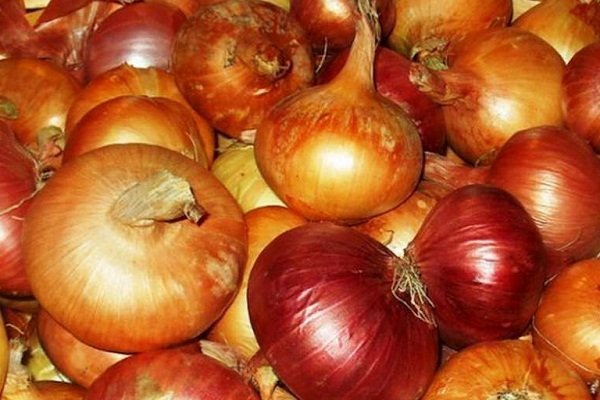

- Star... One of the earliest ripening plants - forms a ripe onion in 55-60 days. Bulbs with yellowish-pink scales and white flesh have a pungent taste and are not afraid of drought.
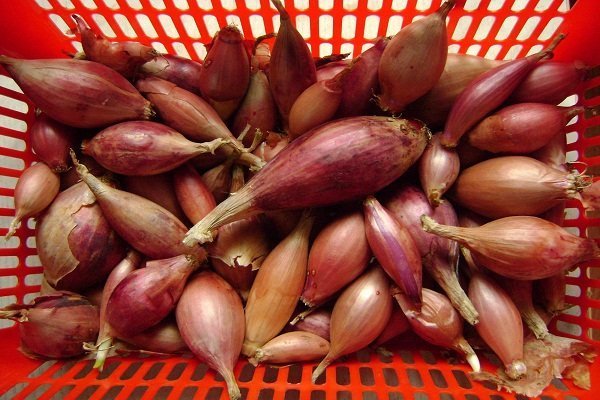

- Off-season... In winter and spring, this particular variety can be grown for greens. The plant forms bright green leaves up to 30 cm long and round-flat fruits weighing up to 20 g.Their scales are yellow, and the inner lobules are white. 8-10 fruits appear in the nest.
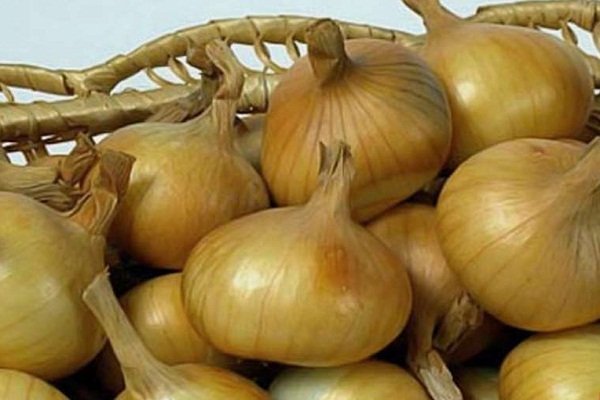

Mid-season
This group includes varieties in which about 70-80 days pass from the emergence of seedlings to lodging of greens. These include:
- Albik... Brings yellow bulbs of rounded flat shape and weighing up to 20-30 g. The heads and feathers have a pleasant semi-sharp taste, therefore they are suitable for adding to fresh salads and vegetable dishes. In one nest, from 4 to 8 bulbs appear, and the yield from 1 hectare reaches 20 tons.
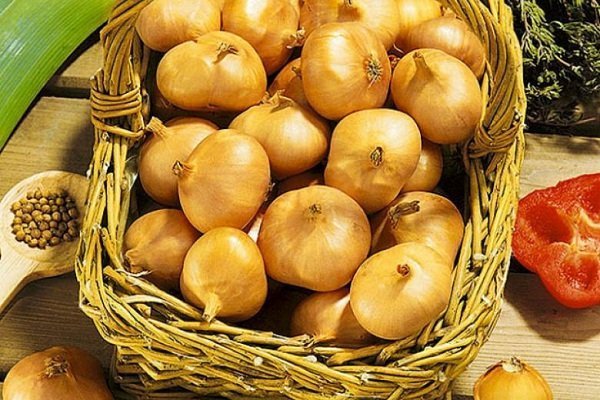

- Ayrat... Onions with a spicy, but at the same time delicate taste, which is more often grown for greens. The rounded heads have yellow or orange husks and weigh on average 15 g. In one nest, up to 5-6 bulbs are formed, and from 1 square. m of the garden, it is possible to collect up to 1.5-5.7 kg of harvest.
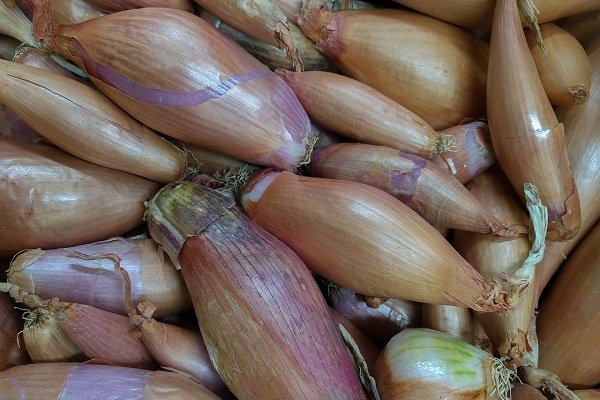

- Andreyka... Semi-hot onion with pink juicy pulp and dark brown hulls. The heads have a transverse elliptical shape and weigh 25 g each. Productivity from 1 sq. M. m - up to 1.8 kg.
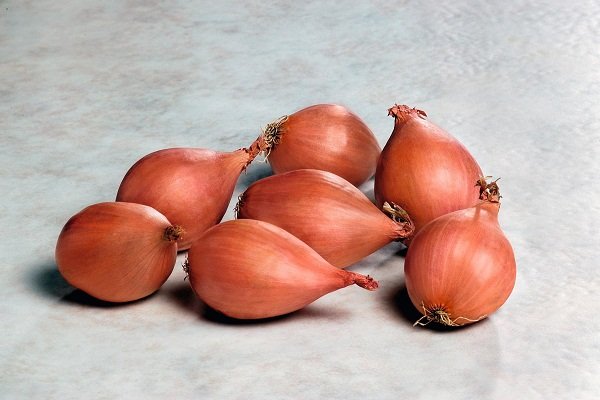

- Afonya... A semi-sharp variety that bears fruit with broad-ovate bulbs weighing up to 30 g. They are covered with dark red scales and have juicy reddish lobules. In one socket, 4-5 heads are formed, and from 1 square. m it is possible to collect 2 kg of onions.
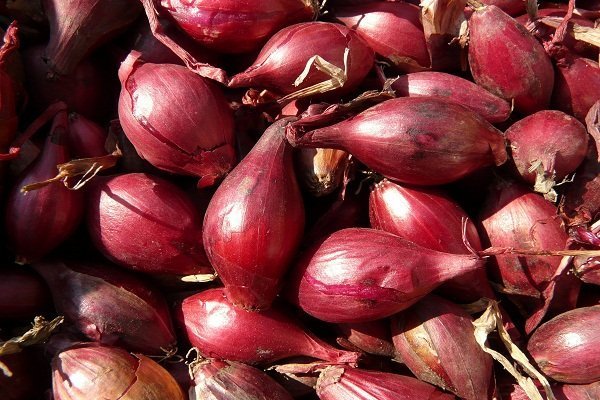

- Bonilla F1... An annual hybrid, the cultivation of which often occurs through seeds in order to obtain greens. Bulbs are obtained weighing up to 32 g, have an oblong-rounded shape, yellow-brownish dry scales and a semi-sharp taste. Each nest consists of 4-5 bulbs, and from 1 sq. m it is possible to collect up to 1.5-1.6 g of the crop.
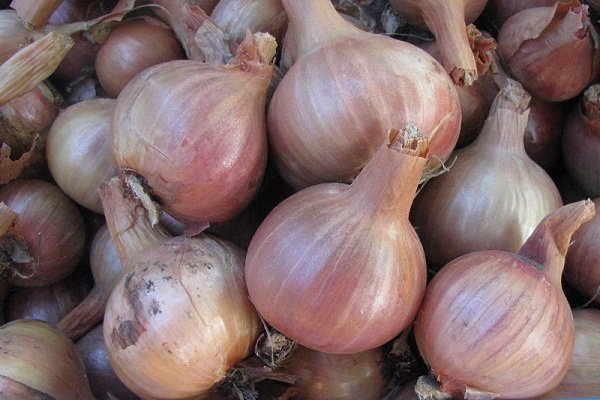

- Guarantee... The plant produces bulbs of round-flat shape and weighing up to 25-32 g. They have a brown husk with a grayish tinge and brown flesh of a mild semi-sharp taste. The variety can be grown for heads and greens. From 1 sq. m of the garden, it will be possible to collect 1.5-2.4 g of the crop, suitable for eating and for conservation.
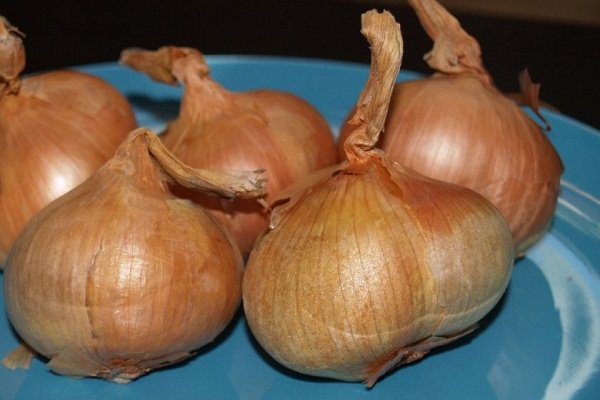

- Miner... The variety brings semi-sharp yellow bulbs, round in shape and weighing 16-18 g. In one nest, 5-7 heads are formed, and the yield from 1 sq. M. m - about 1.5 kg.
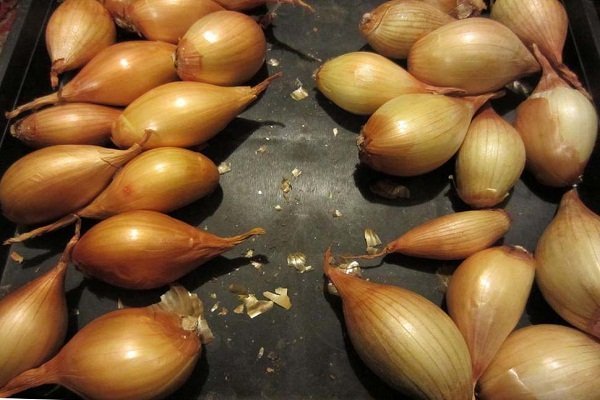

- Guran... A perennial plant that bears fruit in bulbs with a medium-pungent taste, round shape and weighing up to 26-28 g. They have a brownish-gray, brown or light orange husk. In each nest, 5-6 daughter bulbs appear, and the yield from 1 sq. m reaches 1.7-2 kg.
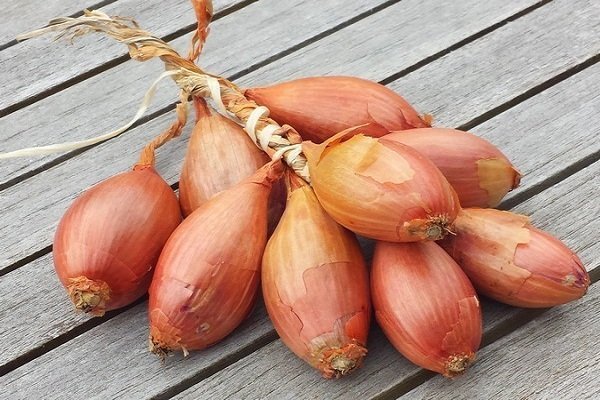

- Kuban yellow D-322... The variety was released by breeders of the N.N. P.P. Lukyanenko and zoned since 1958. In each nest, it forms 4-5 bulbs, which have an oval-flat shape, weight up to 25-30 g, brownish-yellow husk and juicy semi-sharp white or pale green flesh. Productivity per hectare - from 16 to 28 tons.
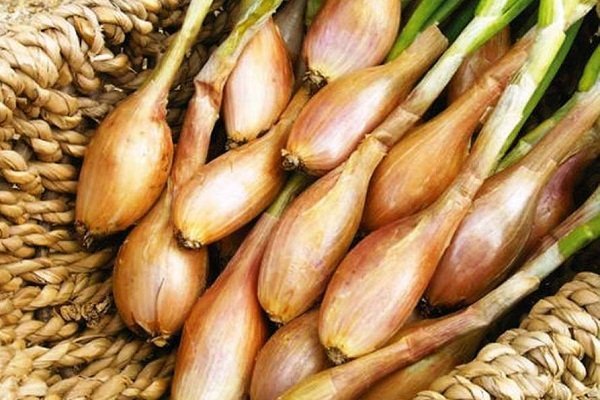

- Kushchevka Kharkovskaya... A variety for universal dining purposes, which in each nest brings 6-7 oval bulbs and weighing up to 25-30 g. They have yellow-brown scales with a purple tint and juicy light purple flesh of a semi-sharp taste. The variety is not afraid of low temperatures and tolerates a lack of moisture in the soil.
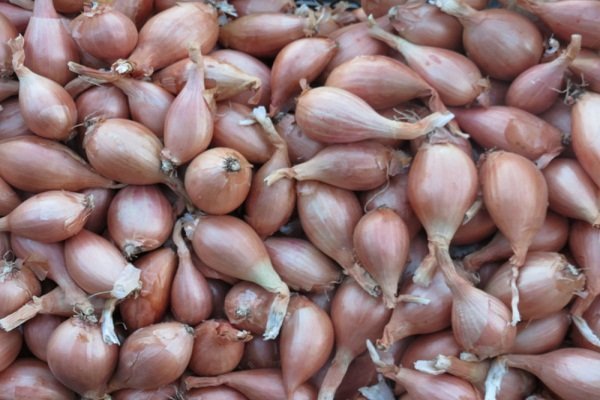

- Earring... A multi-primordial plant that is grown from seedlings in a two-year culture. The bulbs are round, dense and weighing up to 25 g. They have yellow scales and juicy white flesh. They can be stored for up to 8 months.
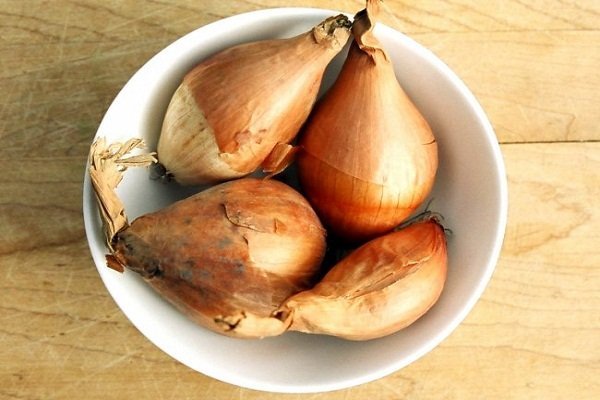

- Sophocles... A productive variety that grows well in all soils and is resistant to fusarium. In each nest, 4-8 bulbs weighing from 25 to 50 g are formed. They have a red or brown-red coating and a purple core with a pungent taste.
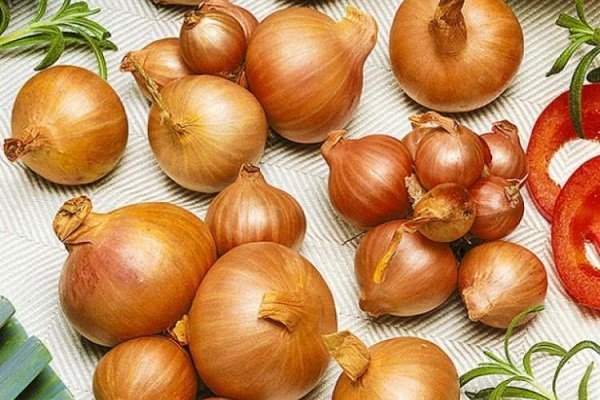

- Ural purple... Unlike other varieties, it has especially large nests - 15 bulbs are formed in each of them. They have an oval-flat shape, weigh up to 25-40 g and have a semi-sharp or sweetish taste. The outer scales are purple-brown in color, and the inner lobules are pink. The plant does not produce shooters and is resistant to rot.
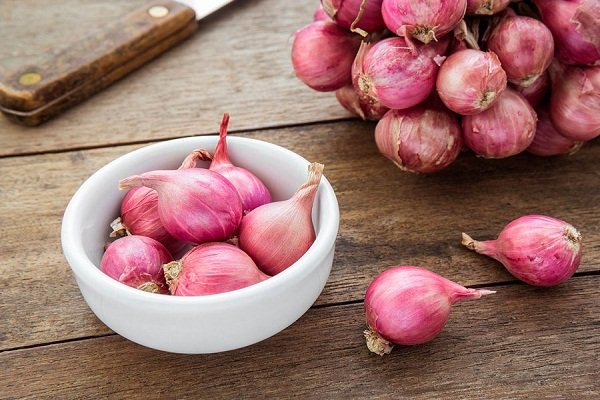

- Chapaevsky... A versatile variety, producing 3 to 8 bulbs in each nest. They have a round-flat or rounded shape, dry scales of a light purple color and the same semi-sweet pulp in taste. Each onion weighs 40 g.
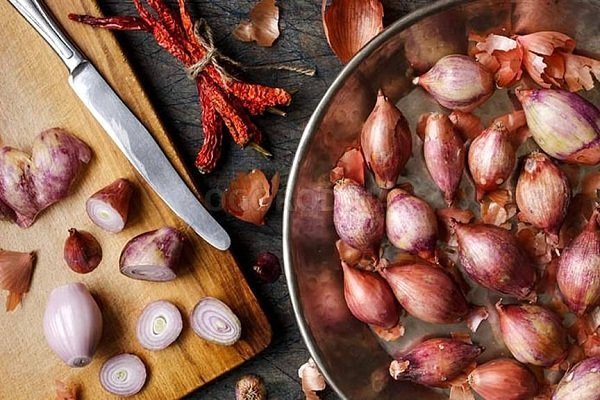

- Firebird... A variety with a semi-sharp taste, which bears fruit in round-flat bulbs with dry yellow-brown scales and weighing from 25 to 30 g.
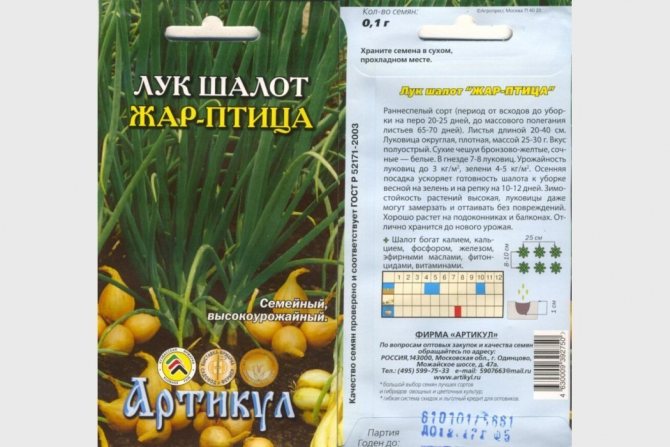

Late ripening
Varieties with a growing season of about 80-95 days. Popular among them are:
- Vonsky... This variety can be grown in unfavorable conditions, as it is resistant to temperature extremes, pests and diseases. In one nest, 3-4 bulbs can appear, each of which weighs about 30-70 g, has a red husk and white flesh with a light purple tint and a semi-sharp taste.
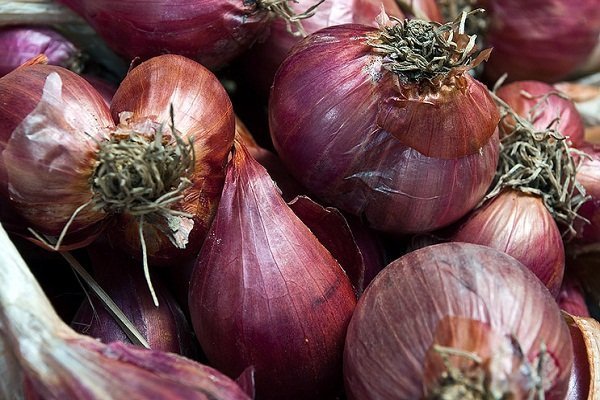

- Kunak... Another variety with a semi-sharp taste, bred in the Krasnodar Research Institute of Agriculture named after I. P.P. Lukyanenko. In each nest, 3-4 bulbs of a round-flat or round shape appear, which have a yellow husk and white flesh. From 1 sq. m of plot, you can collect about 3 kg of greens and 2.6 kg of onion fruits.
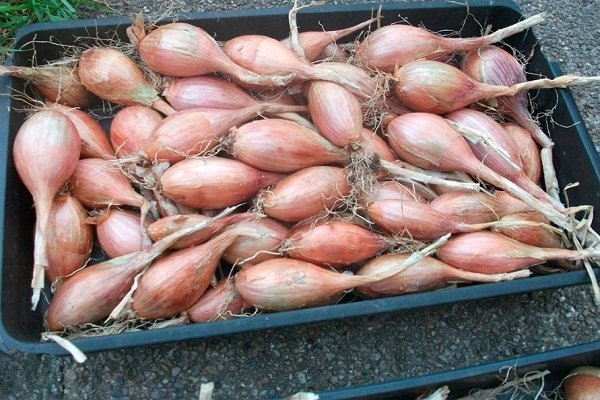

- Sturdy... This variety is not afraid of putrefactive lesions and only rarely gives arrows. In one nest, 4-5 bulbs are formed, each of which weighs 23-52 g, has pink scales and lavender juicy pulp with a semi-sharp taste. From 1 hectare, you can collect 17 tons of fruits, excellent for pickling. The variety is suitable for winter planting.
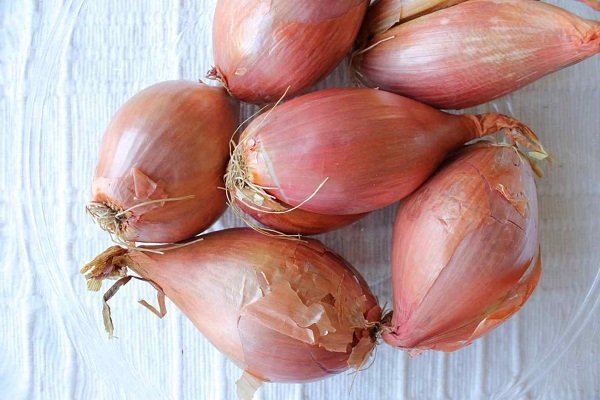

- Siberian amber... The plant tolerates cold weather and is not afraid of putrefactive diseases. In each nest, it forms up to 5-8 onion teeth for table use, which have white flesh with a semi-sharp taste, are covered with orange or yellow scales and weigh 28-30 g. m of the garden, you can collect up to 2 kg of fruit.
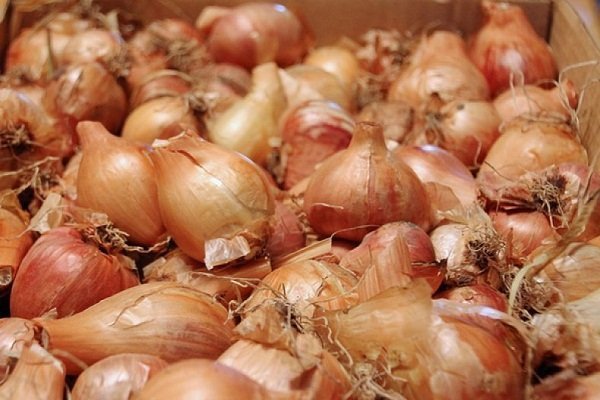

- Merneulsky (Bargalinsky)... Unlike the above-mentioned plants, this variety produces large bulbs - weighing from 50 to 90 g. They have an elongated oval shape, yellow-pink husk and juicy white pulp. One nest grows 4-5 bulbs.
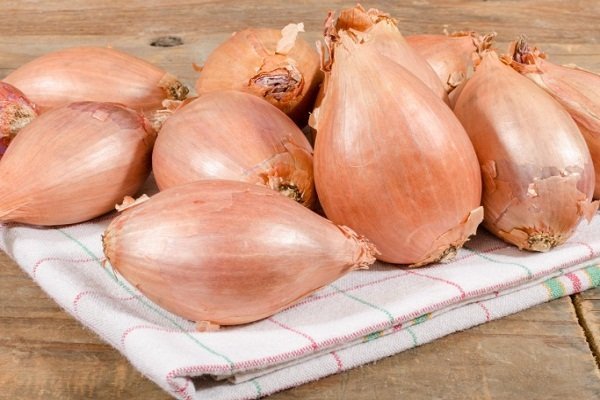

Planting in open ground with sevkom and seeds
It is not difficult to grow shallots, even a novice gardener can handle it. The family grows without problems in the beds in the open field. Even at home on the windowsill, people grow wonderful juicy greens. It is planted with seeds, sets, that is, small bulbs.
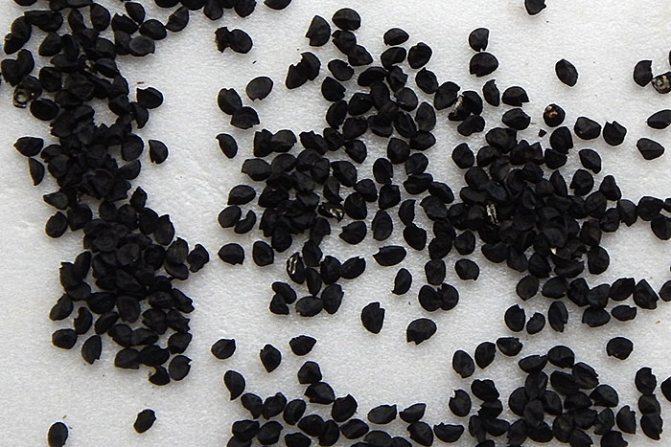

Shallot seeds
It is faster and more convenient to grow this vegetable from seedlings, but in this case it is difficult to find many varieties, while seeds are a great variety. Seeds of shallots are black, small, but have excellent vitality, germination.
Shallots are successfully planted in spring and even before winter. Due to its winter hardiness, it winters well in the ground, giving green feathers in the earliest spring.
To get a rich harvest, it is necessary to observe agrotechnical rules, one of which is the observance of crop rotation.
Predecessors and neighbors
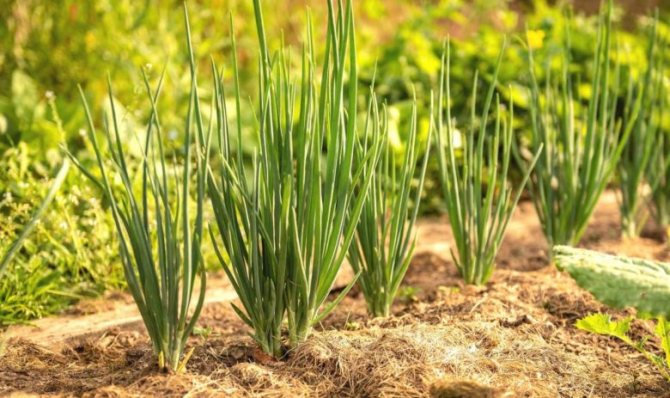

Growing shallots
When planting any vegetable plant, it is worth remembering the importance of observing the rules of crop rotation. To make the plant less sick, get enough nutrients from the soil, plant shallots after good predecessor, for example after any legumes: peas, beans. It is also good to sow it after nightshades. pumpkin crops, cabbage. Not a very good influence this vegetable is rendered by such crops as: corn, garlic, beets, sunflowers, carrots.
Despite the fact that carrots are a poor predecessor, they are also an ideal neighbor for shallots. Planting these two crops side by side is mutually beneficial. Onions scare away carrot flies, and carrots scare off onions. Yet good neighbors for kushchevka onions are radishes, lettuce, strawberries. But the ideal precursors to legumes are bad neighbors kushchevka. Also, do not plant spinach, broccoli next to it, they negatively affect the growth of the vegetable. Knowing the predecessors and planting the right neighbors, it will be easier to grow bushes. And by planting it at the optimal time, you will get a wonderful harvest on time.
Optimal sowing time
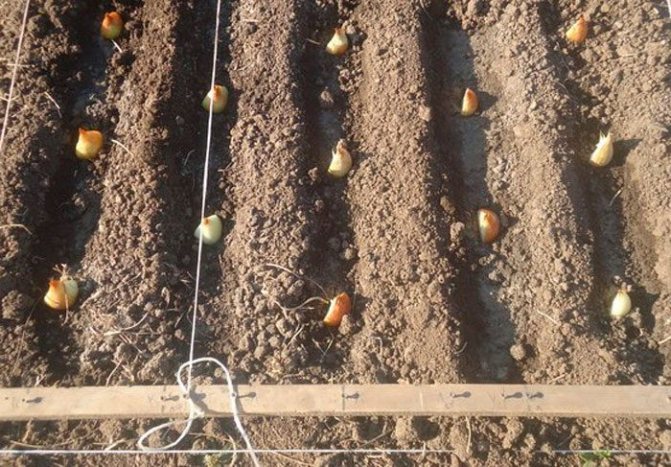

Planting shallots with sevkom
The plant is not afraid of frost, so it can be planted very early. They plant it on a feather as soon as the snow melts. In the southern regions it is the end of February, in cooler areas it is about mid-April. Focus on weather conditions, spring can be early or late. After a month, you can cut off the green feathers, and after a couple of months, enjoy the bulbs. In the spring, when other vegetables have not yet grown, shallots already provide juicy greens. In addition, in a less hot period, excellent quality root vegetables are formed. And in one season, they get several harvests of greenery. If you plant later, you may not get lush greenery.
To get even earlier greens, it is ideal to plant a shallot before winter, shortly before the soil freezes. Planting in autumn depends on the weather, you cannot plant early, you do not need the plant to start growing. When the first warmth comes, you will receive fresh juicy green magpie feathers.
Although this culture is quite unpretentious, choose a site that is best suited for planting.
Site selection and preparation


Home-grown shallots for greens
This culture is sensitive to soil moisture, does not tolerate flooding and close occurrence of groundwater. If the groundwater is close, arrange for good drainage. The shrike loves sunny, open spaces, without shading.
The soil requires light, fertile, chernozems or loams are suitable. The main thing is that the acidity is at the level of 6-7 pH.
To clear the land for planting of weeds, dig up a shovel on a bayonet, loosen it thoroughly. After that, superphosphate, ash, rotted manure or compost are added. Up to 4 kg of manure is applied per m2 of the plot.
After preparing the site, you need to properly prepare the planting material.
Planting material processing
Shallots are planted with seeds and sets. When planting with seeds, no special preparation is required. The seeds are soaked for 48 hours in a damp cloth, then sown into the ground to a depth of 3 cm. The planting scheme is as follows: 20 cm row spacing, 8 cm between seeds.
When planting with sevka, you need to carefully sort the planting material. Rejected damaged, rotten bulbs. It is better to choose medium-sized onions. After that, the set is calcined in the oven at a temperature not exceeding 40 degrees or filled with water at that temperature. They are planted in grooves to a depth of 4-5 cm at a distance of about 10 cm from each other. A small part of the top is left on the surface.
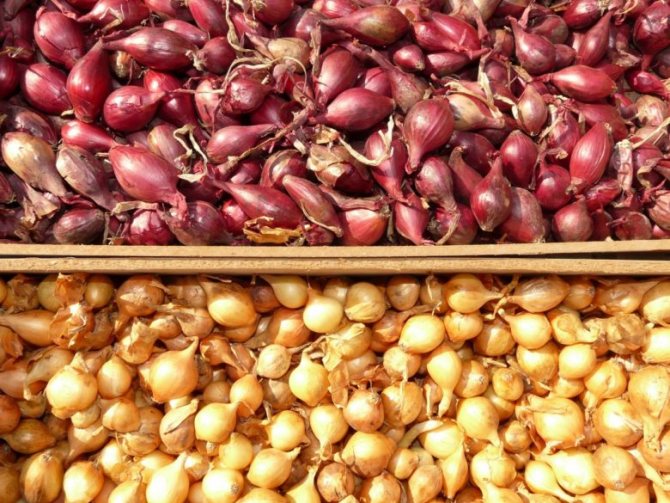

Sevok of shallots
For autumn planting, the planting technology is slightly different.
When to plant?
Depending on the purpose of cultivation, the timing of planting shallots can vary:
- In autumn... To get an early harvest of onion feathers, it is recommended to plant onions before winter, that is, in the fall - in mid or late October, since the culture is not afraid of frost. It should be borne in mind that from the moment of planting to the onset of persistent cold weather, it should take about a month for the plant to take root, but has not yet begun to grow. Such a planting will speed up the harvesting period by 2 weeks.
For podzimny planting, the feathers can be cut in April, and the heads can be collected in June. In order to have vitamin greens on the table in winter, the bulbs must be planted for distillation in room conditions.
- In the spring... To grow full-fledged heads, shallots must be planted in late March - early April. To determine the most favorable time for planting work, it is worth focusing on the weather conditions - the soil should warm up to 8-10 ° C. In such conditions, the plant will be able to get enough of a large volume of melt water. It is not afraid of residual frosts, on the contrary, it is getting stronger and more energetic.
Shallots are frost-resistant crops - they can withstand temperatures as low as -20 ° C and retain their vitality even after freezing.At the same time, planting before winter should be done only in the southern regions.
What is the reason for this feature? The fact is that in the Urals, Siberia and middle latitudes, winter planting can lead to the death of about half of all bulbs due to severe frosts. The surviving plants will form more greenery than the bulbs that were planted in spring, since during winter planting, the tops begin to actively grow immediately after the snow cover disappears.
To determine the exact dates of planting work, gardeners can also be guided by the Lunar calendar. It states that auspicious days for the cultivation of shallots are:
- in March - from 10 to 12, from 15 to 17, from 23 to 25, from 27 to 30;
- in April - from 2 to 9, from 11 to 15, from 24 to 27, 29 and 30;
- in May - from 1 to 4, from 12 to 14, 26 and 27, 30;
- in October - from 4 to 7, from 15 to 17, from 19 to 21, from 23 to 25, 27;
- in November - from 1 to 3.
The lunar calendar determines not only favorable, but also undesirable days for planting shallots. These include:
- in March - 6, 7, 21;
- in April and May - 5, 19;
- in June - 3 and 4, 17;
- in July - 2 and 3, 17;
- in August - 15 and 16, 30 and 31;
- in September - 14 and 15, 28 and 29;
- in November - 12 and 13, 26 and 27.
Growing from seed
Shallots are most often grown by means of sevka. Examine the bulbs carefully - they should be strong, without dark spots and traces of deterioration. When selecting material, be guided by the rule: the larger the onion, the more "daughters" it will bring.
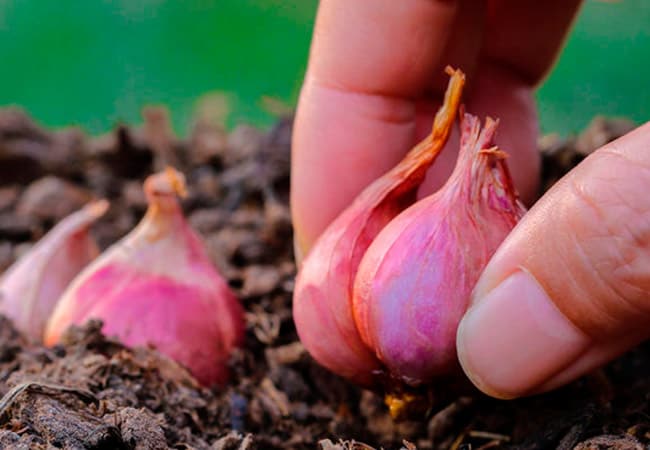

To protect against powdery mildew, the bulbs are heated at a temperature of +40 degrees for 6 hours. The planting site must be prepared - cleared of weeds, dug up and fertilized. The distance between the ridges is 20-25 cm.
They start work when the soil warms up to +5 degrees. Higher temperatures should not be expected. It has been tested that a set submerged in cool soil results in larger bulbs. The deepening depth is 3 cm.
Disembarkation time depends on the region of residence. In the middle lane, shallots are planted at the end of April, in the Kuban - at the end of February. If it happens in the fall, then for the middle zone, the optimal time will be - the end of October, for the Kuban - mid-November. For podzimny planting good varieties "Krepysh", "Garant", "Siberian yellow".
Preparatory work
In order to plant shallots at the chosen time, you need to carry out all the preparatory measures in a timely manner. They consist in the correct processing of both the beds and the planting material. We will consider each stage separately.
Garden bed preparation
First of all, you need to choose a suitable area for the cultivation of shallots. To do this, you need to pay attention to the following parameters:
- Illumination... The site should be well warmed up by the sun's rays, otherwise the fruiting of the plant will noticeably deteriorate in the shade.
- Best predecessors... Crop rotation rules state that shallots are best grown in those places where the following crops grew in the previous season: cucumbers;
- tomatoes;
- zucchini;
- legumes;
- potatoes;
- cabbage.
- corn;
- cucumbers;
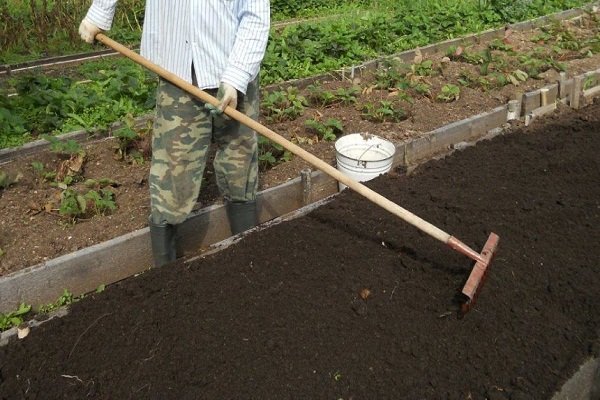

A site with suitable parameters must be prepared in advance.For spring planting, the optimal time is in the fall. The beds need to be dug to a depth of 20-25 cm, all weeds and plant residues must be removed, and then fertilized (per 1 sq. M):
- 30 g superphosphate;
- 15-20 g of potash fertilizers;
- 2-3 st. l. wood ash;
- 3-4 kg of compost or rotted manure;
- 1 tsp urea.
With the arrival of spring, it remains in the formed beds to apply nitrogen fertilizer (25 g per 1 sq. M) and mix it with the soil.
If planting work is planned for the winter, then you need to prepare the site from the summer, following the above sequence.
Planting material processing
To protect the future planting from diseases and stimulate its growth, the planting material must be properly prepared. These can be:
- Onions... First of all, they need to be sorted. The best material is considered to be specimens weighing about 30 g, which reach 30 mm in the crossbar. They are the ones who form a larger number of bulbs. Larger specimens give too many small heads, but smaller ones have low yields and give only late harvests of table and decorative greenery, so it is better to plant them before winter. The selected material must be processed: 7 days before planting, put it in warm (+ 40 ... + 42 ° C) water for 8-10 hours;
- before planting, cut the neck of the sevka along the shoulders in order to accelerate the appearance of greens (this manipulation can be skipped if desired, as it will reduce the yield of both turnips and greens);
- soak the seedlings for 30 minutes in a solution of potassium permanganate or fungicide (for example, in the preparation Maxim).
If you plan to get an early harvest of greens, it is better to plant sprouted shallots in the ground, warmed up in a warm room with high humidity for 2 weeks.
Where is the delicacy used?
The special flavor characteristics of shallots attract the attention of gourmets. This vegetable is not only healthy, but also gives the dishes a special taste and unique aroma.
Shallots and onions are not interchangeable vegetables. These are two completely different ingredients.
Why shallots are in demand in cooking:
- has a delicate onion taste without characteristic bitterness, harmoniously combined with tomatoes, radishes, cucumbers and other vegetables;
- harmonizes with the creamy taste of avocado;
- contains a lot of sugar, therefore it caramelizes better than onions;
- small and dense onions are more suitable for pickling - excellent pickles are obtained;
- ideal for baking - shallots are delicious baked in combination with butter, honey and dried fruit;
- shallots when fried, especially in butter, gives much more flavor than onions;
- it is easy to remove the husk from the shallots with boiling water.
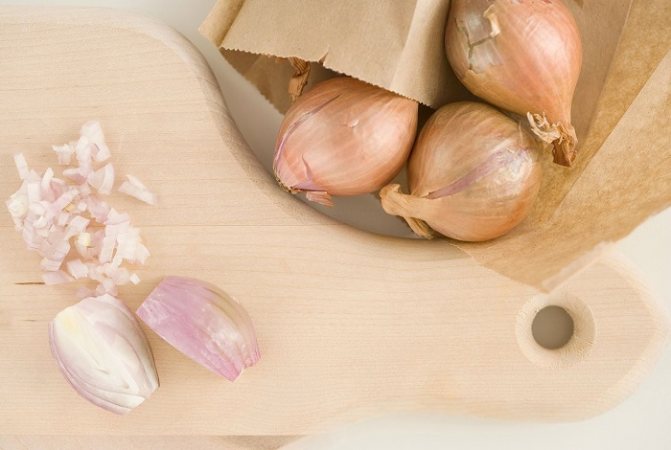

How shallots are used in cooking:
- Seasoning for meat. The onions are finely chopped or cut into rings. They are poured over ready-made meat - baked in the oven or shish kebab.
- Side dishes. The simplest onion garnish is prepared by frying. The onions are peeled and fried whole. When they are softened, they are removed from the heat and served as a side dish with meat dishes. The second option for preparing a side dish is baking. By mixing olive oil and honey, a thick sauce is obtained. Pour the onions with this sauce, sprinkle them with spices and put them in the oven for 30 minutes (temperature +150 ° C).You can add dried fruits or crushed nuts to the resulting caramel casserole.
- Fillings for pizzas and pies. Chopped onions are fried in oil and added to the filling. Fried onions go especially well with meat and fish fillings.
- Salads. The delicate taste and soft consistency of the bulbs are ideal for fresh vegetables.
- Cream soups. Shallots are used as one of the key ingredients in many soups. An example of making a creamy soup with spinach, shallots and garlic:
- 0.5 kg of spinach is blanched in salted water, squeezed and chopped in a blender;
- chop onion and garlic and fry in olive oil;
- 1.5 kg of spinach leaves are added to the onions and garlic, and continue to fry;
- mix the fried mixture with the green puree, season and stir.
- Sauces. Shallots add spice to many sauces without overshadowing the flavor of other ingredients. Onion-wine sauce:
- The onions are chopped and fried.
- Red wine is mixed with potato starch. Stir and add to the onion.
- Sprinkle the mixture with spices and stew for 10 minutes.
- Blanks. Shallots are especially popular for pickling. How to pickle shallots:
- A standard marinade is prepared from spices, salt and sugar. Vinegar is poured into the boiling marinade.
- The bulbs are placed in jars and covered with marinade.
- The jars are sterilized for 10-15 minutes and sealed with lids. It turns out a ready-made appetizer and a base for salads.
When cooking shallots, care must be taken - if overcooked, it will acquire an unpleasant bitter aftertaste.
Shallots are used in folk medicine. Its use is useful for:
- vascular diseases;
- unstable blood pressure;
- cardiovascular diseases;
- metabolic disorders;
- malfunctions of the digestive system.
Shallots are a source of potassium and sodium and are therefore especially beneficial for heart function.
This vegetable can work as a catalyst - it promotes the breakdown of fats and their absorption by the body. And carotene, which is part of the shallot, improves the functioning of the eye muscles, the condition of the retina and lens.
Planting shallots
The prepared planting material must be planted in moist soil, adhering to the following scheme:
- the distance between the rows is 30-40 cm;
- the distance between the bulbs in a row is 20-30 cm;
- the distance between seeds in a row is 8-10 cm;
- the planting depth of the bulbs is 2-3 cm (with a deeper planting, the growth of greenery will be delayed and the yield of the variety will decrease, and if they are planted at a shallower depth, then the bulbs will bulge out from under the ground);
- the seeding depth is 11-13 cm with the bottom down (however, in the southern regions it is not worth deepening the shallots deeper than 10 m, since too strong planting will increase the harvest time).
After planting, the bulbs should be sprinkled with soil mixed with wood ash (3: 1) and watered. The planting should also be mulched - covered with a layer of peat or humus with a thickness of 3.5 to 4 cm.If the onion is planted in the fall, then the beds can be covered with spruce branches, which will need to be removed in early spring.
If the seedlings are not additionally protected from the cold, they can withstand temperatures as low as -25 ° C. At lower rates, the crop yield can be reduced by 3 times.
How to plant and grow shallots is clearly shown and described in the video below:
Features of obtaining seeds of Ashkelon onion
Shallot planting material always needs updating, otherwise the culture will often get sick, degenerate, and the bulbs themselves will become smaller.
Important!
Replace the shallots with new ones every three to four years.
For renewal, you can grow your own seeds, but this is quite laborious. As already mentioned, shallots are not prone to shooting, so if you want to grow your seed, you will need to "force" the onion to release arrows. This requires:
- select high-quality and large shallots (it is better to take three-year-olds);
- withstand them before planting for 3-4 months at a special temperature regime: from 5 to 10 degrees.
Then, in the spring, the bulbs are planted on the ridges as usual.
On a note!
To obtain arrows, it is advisable to plant such a bow as early as possible.
Specimens that have undergone special processing will shoot, forming flowers, and then umbrellas with seed pods.
Important!
Planting shallots next to onions is not allowed, otherwise cross-pollination will occur.
A feature of the culture is that seeds are not formed in every box, so you need to be very careful about collecting. The umbrellas are cut when the first boxes are opened, and then they are thoroughly dried.
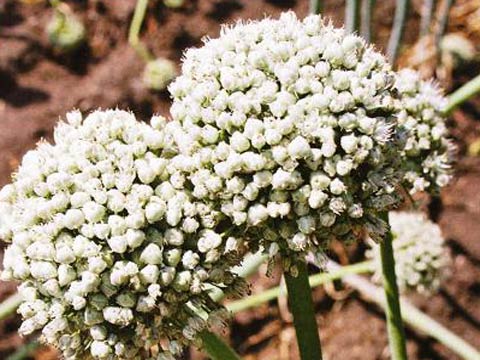

It is convenient to make a special bag of gauze or other lightweight fabric, tie it around the heads of the arrows, tied in a bundle and hung to dry. After about three weeks, the boxes will dry out, dry seeds are removed from them, peeling them off.
Shallots care
After the sowing activities, the final stage in the cultivation of the crop begins, which consists in caring for the seedlings. It involves some manipulation.
Watering
Throughout the growing season, the garden bed must be watered at least 3 times. In this case, a number of recommendations should be taken into account:
- Water the crop abundantly only after sowing. In the future, it is enough to simply moisten it, preventing excessive drying of the soil.
- When organizing watering, focus on weather conditions. On rainy days, refrain from additional moistening of the soil at all, and on dry days - water once every 7 days.
- 21-28 days before harvesting, minimize the introduction of nutrient moisture so that the feathers can turn yellow and dry completely.
- At the beginning of July, stop watering, otherwise the bushes will actively grow greenery, and the bulbs themselves will turn out to be very small.
Loosening and weeding
In order for the plant to receive enough oxygen, you need to regularly loosen the soil - 1-2 times a week. Such manipulation will not allow a thin crust to form on the surface of the soil, which prevents the uniform distribution of moisture to the roots of plants.
Together with loosening, it is necessary to weed the site, eliminating rapidly growing weeds that clog useful plantings. Weeding is also considered an effective method of pest control and prevention of viral diseases.
Top dressing
During the growing season, the culture must be fed at least 2 times, adhering to the following scheme:
- First feeding - with the appearance of the first 3 feathers... You can fertilize the planting with various compositions:
- organic fertilizer - a solution of mullein (1:10) or bird droppings (1:15) at the rate of 1 bucket per 10 sq. m;
- a mixture of ammonium nitrate and superphosphate in a proportion of 10:10 g per 1 sq. m;
- solution of 1 tbsp. l. urea or urea and 0.5 tbsp. l. potash fertilizer in a bucket of water.
- The second feeding - at the stage of bulb formation or with the appearance of 5 feathers... During this period, the plant especially needs phosphorus and potassium, so it should be fed with a mixture of 10 g of potassium chloride and 15 g of superphosphate per bucket of water.
30 days before harvesting, completely stop all feeding, otherwise greens will actively form to the detriment of the bulbs.
Thinning
As soon as the arrows appear, they must be broken off immediately so that they do not reach 10 cm.In the first days of July, you also need to thin out the nests - shake off the ground from them and remove all the small heads along with the greens, leaving 5-6 of the most developed primordia.
Doing so will yield larger bulbs. The harvested bulbs and feathers can be used for cooking or freezing.
How the thinning of family onions is carried out is demonstrated in the video below:
Protection against diseases and pests
For shallots in rainy and cloudy weather, the following fungal pathologies are dangerous:
- powdery mildew;
- peronosporosis (downy mildew);
- neck rot;
- fusarium wilting, etc.
Infected specimens will begin to cover with various lesions and gradually fade. It is almost impossible to save them, so it is necessary to dig up diseased plants as soon as possible and destroy them. The remaining planting must be treated with a fungicide - Mikosan, Quadris or Pentofag.
After spraying with chemicals, shallots should not be eaten for some time (the duration of exposure to toxic elements is indicated in the instructions for use of the drug).
The following pests are no less dangerous for shallots:
- Onion fly... Appears with cherry and dandelion blossoms. Because of the fly larvae, the tips of the leaves turn white, rot and completely wither. In the fight against the pest, the bushes and the soil around them must be treated with wood ash.
- Worms... To get rid of them, the foliage of the plant must be watered with saline (1 glass of salt for 1 bucket of water).
- Onion nematode... Causes a curvature of the bottom of the mother's bulb and infects the entire planting. In order to prevent the death of the entire crop, you must immediately remove the affected plants. Proper processing of the planting material will help protect against the nematode - it must either be warmed up in warm water for 60 minutes, or soaked for several minutes in a 4% formalin solution.
- Garden aphid... It settles on the feathers of the plant and gradually sucks out the vital juices from them. In the fight against aphids, seedlings can be treated with a decoction of pepper, potato peel or pharmacy chamomile. Among chemicals, Verticillin is effective.
Diseases and pests
Onions are rarely attacked by pests and a number of diseases.
| Problem | Remedy |
| An uneven white stripe forms near the bottom of the bulb. | Onion nematode is a small worm. The sevok is soaked for 2 minutes in a 4% formaldehyde-methanol solution. Can be immersed in hot water at 45 ° C. |
| Feather tips whiten, wither. The bulbs are rotting. | Light gray onion fly with green back. Carrots planted nearby drives her away. Can be spread between the rows of wormwood or tansy. |
| Aphids prefer young shoots, sucking the juice. | Sprinkle with cooked broth (chamomile, hot pepper). You can use special preparations. |
| Powdery mildew, fusarium, downy mildew, bottom rot | Fungal diseases. Healthy turnips are treated with insecticides. The sick destroy. |
Harvesting and storage
From mid-July, you need to start cutting the feather, otherwise during harvesting, you can cause the active growth of torches and the development of green feathers in them. The crop itself must be harvested at the end of July. The signal for this will be the drying and yellowing of most of the leaves, since this process is accompanied by the death of the roots at the bottom.
Ripe bulbs need to be dug up with a shovel and carefully pulled out of the ground, and then shaken off and dried in the sun for 20-30 days. In cloudy weather, the onion fruits extracted from the soil must be removed to a shaded place for drying for several days.
Dried leaves must be cut off, leaving only a thin neck 3-5 cm high. Next, dry heads must be disassembled into bulbs. They can be stored in boxes, crates or nets and stored in a dry and cool place. In this form, the vegetable can be stored from 5-7 to 12 months. At the same time, the bulbs must be regularly inspected, timely removing rotted specimens.
The removed bulbs can also be stored frozen. This is done in the following order:
- Peel the bulbs.
- Cut large heads into pieces.
- Moisten the bulbs slightly and place in the freezer to freeze.
- Transfer the frozen product to a plastic container and put it back in the freezer for storage.
Using the same technology, you can freeze shallots. With this storage, the vegetable retains all its beneficial properties.
How the shallots are harvested can be seen in the video below:
Cooking applications
Shallots are widely used in cooking.It has a sweet taste and a pronounced aroma. For cooking, not only fresh but also pickled onions and leaves are suitable. In both the first and second cases, soups and sauces will become even tastier. Shallots are added to salads, they are seasoned with fried meat and even baked whole.
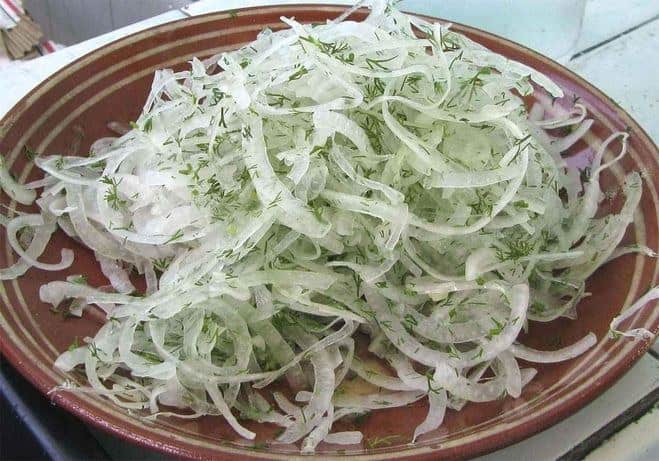

Shallots provide gourmets with an endless field of experimentation. It is marinated in red vinegar, mixed with mashed potatoes and, combined with yogurt, served with a kebab. The Chinese love shallot chips. By the way, it's very tasty. Each of the peoples managed to inscribe this onion in the national menu, thus adding something memorable to it.
Video: growing and storing shallots
Candidate of Agricultural Sciences Lyudmila Nikolaevna Shubina talks in detail about how to grow and store family onions:
A more tender and sweet analogue of onions is shallots, which even a novice gardener can grow. The plant easily adapts to adverse weather conditions and does not require careful maintenance. At the same time, the culture gives an excellent yield of feathers and multi-purpose bulbs. They can be eaten immediately or stored for up to 12 months.
0
We plant shallots according to all the rules
Usually a bush is planted to obtain feathers. They ripen quickly and remain tender and juicy for a long time. To get a good harvest, plant shallots in unprotected soil in April-May. The vegetable grows well at home. If you decide to plant it on the windowsill, then the best time for this is the beginning of March. Feathers can be collected within a month. It is noteworthy that after cutting the leaves, the bulb can be used a second time. To do this, they take it out of the soil, cut off half and put it back in the ground.
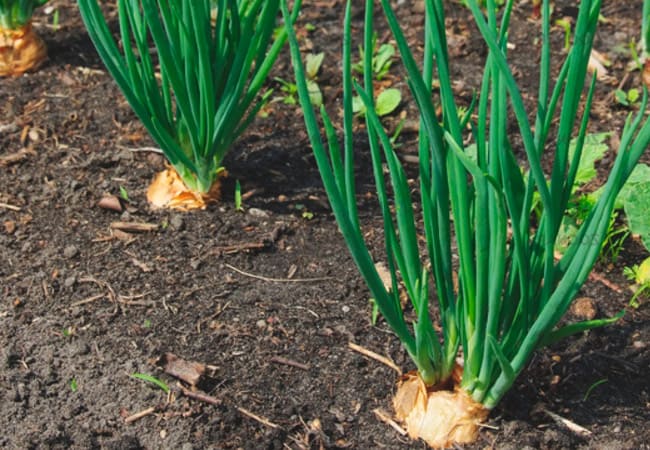

Spring planting
In the spring, shallots are planted to produce both feathers and bulbs. Better to plant at the end of April. The soil is prepared in advance - in the fall. Dig in, remove weeds, add compost (6 kg per 1 m2), superphosphate (60 g per 1 m2) and a little ash. Forms ridges with an interval of 25 cm. Everything. In the spring, it remains to loosen them and add a nitrogen complex at the rate of 30 grams. per 1 m2.
Seeds require preliminary preparation. They are wrapped in two layers of gauze and immersed in water for two days. The water temperature is +22 degrees. Every 7 hours, the seeds are taken out of the water, rinsed and dipped back into a container with fresh water. Then the seeds are dried and then planted in the ground. Sprinkle peat on top of the beds and water them.
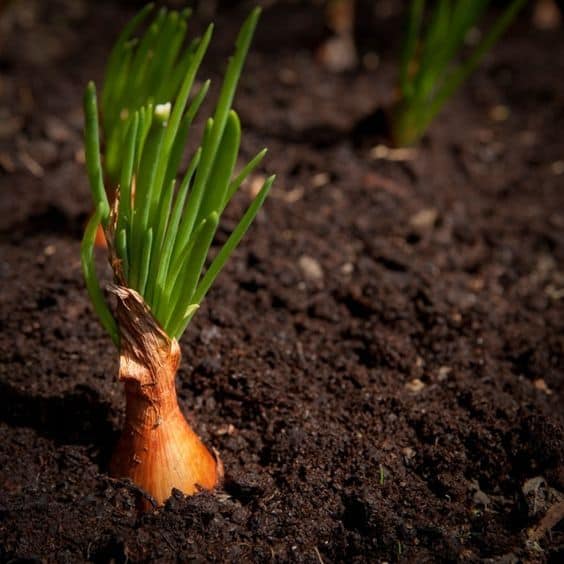

In the first year, a bulb will grow from the seeds, inside which there will be 4 more small bulbs. To get more specimens next year, these 4 bulbs should be planted. The resulting material can be planted within 4 years. Then it should be updated.
Autumn planting
Despite the fact that shallots are immune to low temperatures, it is better to plant them for the winter in the southern regions. If you want to harvest in early spring, then sow the vegetable in October. So he will have time to take root without the formation of shoots before the onset of frost.
Remove dry foliage and grass from the selected area. Dig up the soil thoroughly, add compost to it. There is no need to prepare the seeds - just sow them into the formed beds and sprinkle with earth. Be sure to cover the planting with plastic.

